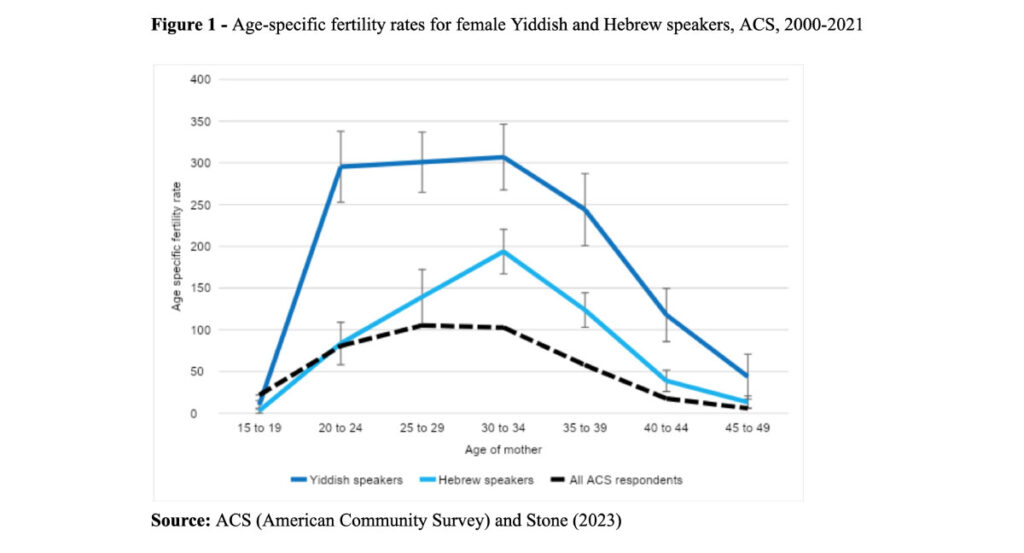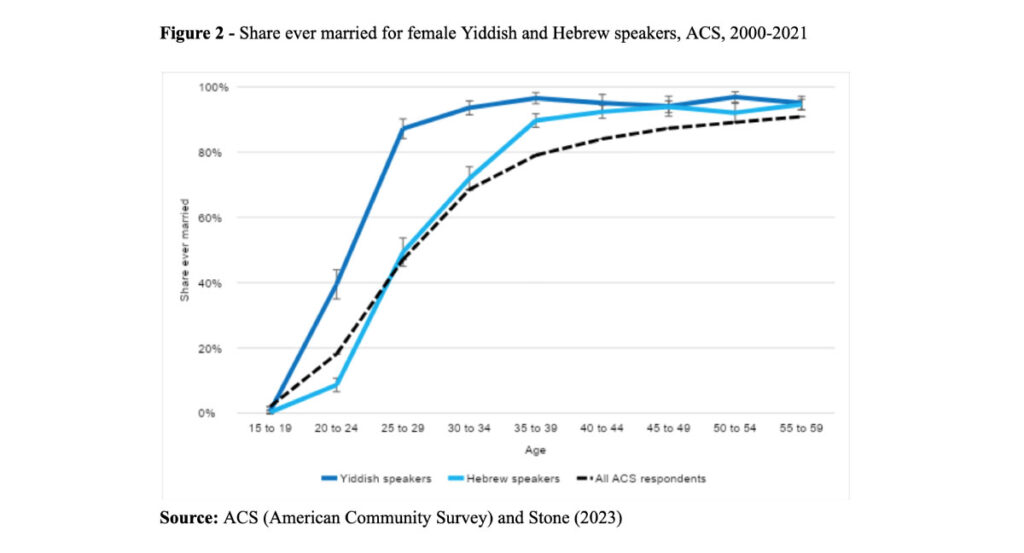Ultra-Orthodox Jewish communities are known to have high fertility, but details are difficult to investigate because questions about religion and fertility are rarely asked together in surveys. Lyman Stone’s ingenious exploitation of ACS (American Community Survey) data sheds some light on the issue.
Around the word today, about 14% of Jewish people are Ultra-Orthodox, a figure projected to rise to 23% by 2040 thanks to high birth rates among Ultra-Orthodox Jewish communities (Staetsky 2022). This continues a pattern of strong demographic growth which has been ongoing for decades, as fertility rates among other Jews have fallen to around 1-3 children per woman. Prior studies in the United Kingdom and Israel suggest that Ultra-Orthodox Jewish women in those countries have 6 to 7 children on average, a figure similar to that derived from two surveys with small Ultra-Orthodox Jewish samples in the United States (Pew 2013, Staetsky and Boyd 2015, Pew 2020, Hleihel 2020). However, it has been difficult for researchers to get a detailed understanding of exactly how fertility operates among Ultra-Orthodox Jews because they are rarely represented in conventional surveys due to their small population size. The prior studies mentioned above are mostly based on small samples from larger surveys on other topics collected somewhat incidentally, or periodic data from full censuses. As many government surveys don’t ask about religion, Ultra-Orthodox Jews are not identifiable, even in surveys where Jewish communities may be included. This poses a challenge: a very rapidly growing, high-fertility group (and one subjected to high levels of discriminatory violence) is of obvious interest to policymakers and researchers, and yet very hard to study due to data constraints. In particular, many high-fertility communities are characterized by high rates of child marriage, suppression of women’s access to contraceptives, and high rates of teen and undesired childbearing.
What ACS data can reveal about Ultra-Orthodox Jewish fertility in the US
To overcome the challenge of limited data and better understand the exact dynamics of Ultra-Orthodox Jewish fertility, in a recent study (Stone 2023) I leveraged one particular quirk in American data collection: the American Community Survey, which surveys millions of Americans every year and includes questions about childbearing, includes a question about language spoken at home. Today, almost all reproductive-age Yiddish-speakers in the United States are Ultra-Orthodox Jews (though some Ultra-Orthodox Jews do not speak Yiddish at home), meaning that Ultra-Orthodox Jews can be studied obliquely by analyzing the behaviors of people who speak Yiddish at home.
Using this data, I find several striking facts. First, Yiddish-speakers in the United States averaged a total fertility rate of around 6.6 children per woman over the period 2000-2021. This figure, slightly higher in 2010-2021 than in 2000-2009, suggest that Ultra-Orthodox Jews have avoided the fertility decline observed in most populations in the industrialized world. In contrast, Hebrew-speakers in the United States (largely Israeli immigrants and dual citizens) had total fertility rates of around 3-4 in the early 2000s, falling to around 2-3 in the latest decade (though still higher than the ~1.7 observed for all Americans).
Where do these high birth rates come from? They are not a product of teen pregnancy: teen birth rates are actually lower among Ultra-Orthodox Jews than Americans more generally (Figure 1). Ultra-Orthodox fertility rates are very low before adulthood, then skyrocket in early adulthood and remain elevated throughout the reproductive life course, but especially in the 20s and early 30s. At age 45-49, Ultra-Orthodox Jewish women report fertility rates similar to the general American population an entire decade younger.

Thus, the first possible assumption about Ultra-Orthodox Jewish communities – that they achieve high fertility partly through very early childbearing before adulthood – turns out to be completely wrong. Ultra-Orthodox mothers are more likely to be adults than American mothers generally.
Marriage
In many high-fertility populations, marriage comes very early, for young girls in particular. Is this the case for Ultra-Orthodox Jews?
The answer, as shown in Figure 2, is no. Rates of marriage before 20 are about the same for Yiddish speakers as for American women generally (and in single-year-of-age data, rates are actually appreciably lower at ages 15-17, then rise at 18 and especially at age 19). Ultra-Orthodox fertility is not fueled by child brides, but rather by higher rates of adult marriage.

Probing deeper, I find that Ultra-Orthodox Jewish couples also tend to have fairly age-egalitarian marriages. Whereas in some traditional high fertility societies grooms are much older than brides, among Ultra-Orthodox Jews marrying for the first time in my sample, grooms averaged 22.2 years old, and brides 21.0, a gap of 1.2 years. By comparison, for Americans generally, grooms were 30.1 years old and brides 28.5, a gap of 1.6 years. In general, Ultra-Orthodox Jews may actually have fewer age-unequal marriages than other populations in the United States.
Finally, while my data do not include a variable for contraception, I find suggestive evidence that Ultra-Orthodox women have access to it and do use it. Comparing estimates for married Ultra-Orthodox Jewish women to three historic “natural fertility” populations (i.e. without any form of birth control), at age 15-19, the birth rates of Ultra-Orthodox wives are 74% lower. At 25-29 they are 32% lower, at 35-39, 37% lower, and at 40-44, 49% lower. Thus, Ultra-Orthodox wives have much lower fertility than observed in historic “natural fertility” populations, especially for the few very young brides in the sample and for older wives. Thus, even though Ultra-Orthodox wives have about twice the age-specific fertility rates as American wives generally in the available data, their lower fertility rates than natural fertility populations are strongly suggestive of intentional fertility control. Correspondingly, prior research has found significant contraceptive usage in small samples of Ultra-Orthodox Jewish women (Okun 2000, Sabiner et al 2020); and, notably, various schools of Jewish religious thought permit a range of contraceptive and abortive practices in certain circumstances.
Concluding remarks
In sum, I find that Ultra-Orthodox Jews in America, proxied through the use of the Yiddish language, have similar birth rates to Ultra-Orthodox Jews in other contexts: around 6 to 7 children per woman. These high birth rates are entirely driven by high rates of adult marriage and adult marital fertility; teen fertility and nonmarital births are far less common among Ultra-Orthodox Jews than among Americans as a whole. The specific age pattern of marital fertility suggests that Ultra-Orthodox Jewish women are able to control their fertility. High fertility among Ultra-Orthodox Jewish women is fundamentally dissimilar from that of many other high fertility populations, and may be a product of conscious choice and even a kind of family planning, but for a large, rather than small, family. Correspondingly, Ultra-Orthodox Jewish fertility is relatively free of some of the major indicators of risky fertility behavior, and should probably not be a subject of particular public health concern.
References
Hleihel, A. (2020). Fertility of Jewish and Other Women in Israel, by Level of Religiosity, 1979-2019. Working Paper. Central Bureau of Statistics. Retrieved March 12, 2022.
Okun, B.S. (2000). Religiosity and Contraceptive Method Choice: The Jewish Population of Israel. European Journal of Population, 16, 109–132.
Pew Research Center. (2013). A Portrait of Jewish Americans. Pew Research Center Report.
Pew Research Center. (2020). Jewish Americans in 2020. Pew Research Center Report.
Sabiner, Y., Rottenstreich, M., Grisaru-Granovsky, S., & Seidman, D. S. (2020). Use of contraception among ULTRA-ORTHODOX Jews: A matched case-control study. Fertility and Sterility, 114(3).
Staetsky, L.D. (2022). Haredi Jews around the world: Population trends and estimates. Institute for Jewish Policy Research, May 2022.
Staetsky, L.D. and Boyd, J. (2015). Strictly Orthodox rising: What the demography of British Jews tells us about the future of the community. Institute for Jewish Policy Research.
Stone L. (2023). Ultra-Orthodox fertility and marriage in the United States: Evidence from the American Community Survey, Demographic Research, 49(29): 769–782-


